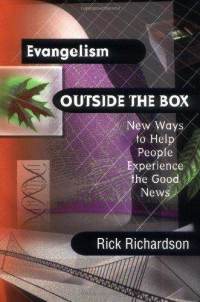
The premise of this book is that lost people matter to God and He wants partners in the search party. However, it has been difficult for churches to continue their effort in engaging the lost. The book begins with a helpful illustration of the “boxes” we live in, and how to start “thinking outside the box.” God is responsible for changing people. However, He expects us to partner with Him. The world has changed (from modernism to post-modernism) and this book does a very good job explaining that difference (32-34).
The fact that the church has become a barrier to evangelism because of our arrogance and benevolence (36) is very true. As a result, we have to look at the questions the world is now asking, instead of responding with answers to questions which are outdated. The book does a very good job explaining our answers are to out-dated questions with a brief history of the major transitions in history. (42-44). Specifically, the explanation of the differences between medieval, modern, and post-modern are a very helpful primer for today’s church who wants to engage the culture and reach new people for Jesus Christ (45).
The explanation of the type of truth that the post-modern world is seeking should be very helpful. For example, I agree with the insight that truth should be integrated, and not just propositional. The post-modern world is looking for truth which is not universal, but real. This does not deny that God’s truth is universal. Instead, it reveals that culture is not interested in universal truth as an answer to their questions. The post-modern culture is interested in a pragmatic, yet experiential solution to their concerns.
The answer is still Jesus Christ and the Bible as God revealed it, but the way in which it answers their questions will be different. As a result, the pastor will have to use a different set of tools to address these questions and point these people to Christ. In the past, being an expert and having all the answers were what gained the church credibility and a hearing. Today, the post-modern culture does not want experts, nor do they need them. Instead, the post-modern culture desires that their leaders share the same questions, struggles, and hurts. Being authentic builds credibility and this gains the church a hearing. The post-modernist become convinced about moral and spiritual choices as an artist, not as a scientist. They do not respond to logical verbal arguments, but by visual stories (47-49).
This changes the way evangelism should work. Experience comes before explanation, belonging comes before believing, and image comes before word (51-52). Since the order and process of salvation has changed. This reviewer agrees with the assessment that effective soul-awaking events and efforts are the weakest links in the attempts to reach people in today’s world (55). The writer of this book uses a different presentation, “A Circle of Belonging” (132-140), as a way to explain the gospel. He also suggests that transformation is more than just saying yes to Jesus. To this reviewer, transformation requires that the Christian also says no to “ungodliness” (Titus 2:11-12). We don’t just repent, but we must also renounce our false identities (144). Even after a person becomes a Christian, there are barriers to living the Christian life. Eliminating these barriers is a post-modern form of discipleship.
The book addresses the methods of Jesus (84) and Paul (88). The hermeneutical foundation is solid. We are to use the Bible to answer the questions. The book suggests and alternative approach. Instead of starting with what the Bible says is true, the authors suggest that a pastor should look to the culture to address a need, and then answer that need with how God answers that need in the Bible (88). The authors suggest that we should argue to our truth basis, not from our truth basis (93). As a result, the biblical foundation stays the same, but the way in which we approach the Bible will be different. We need to address the people like Paul in Acts 17, and less like Peter in Acts 2.
The book spends enormous energy challenging the church to engage the post-modern culture. Then as a caveat (in an appendix no less), the authors state: “reports of the demise of modernism are premature ad exaggerated” (168). This is only true to the diminishing number of modernists. Modernism is on its deathbed. Post-modernism is the new resurrected form. The church needs to engage the resurrected form with a resurrected Christ. Trying to reach people who subscribe to modernism will become increasingly wasteful.
This book spends time describing the nature of the post-modern world which we are called to reach. Other books such as Stanley Grenz’s A Primer on Post-Modernism, Leonard Sweet’s SoulTsunami, Ed Stetzer’s Planting New Churches in a Post-Modern Age, and Rex Miller’s The Millennium Matrix compliment this text.












